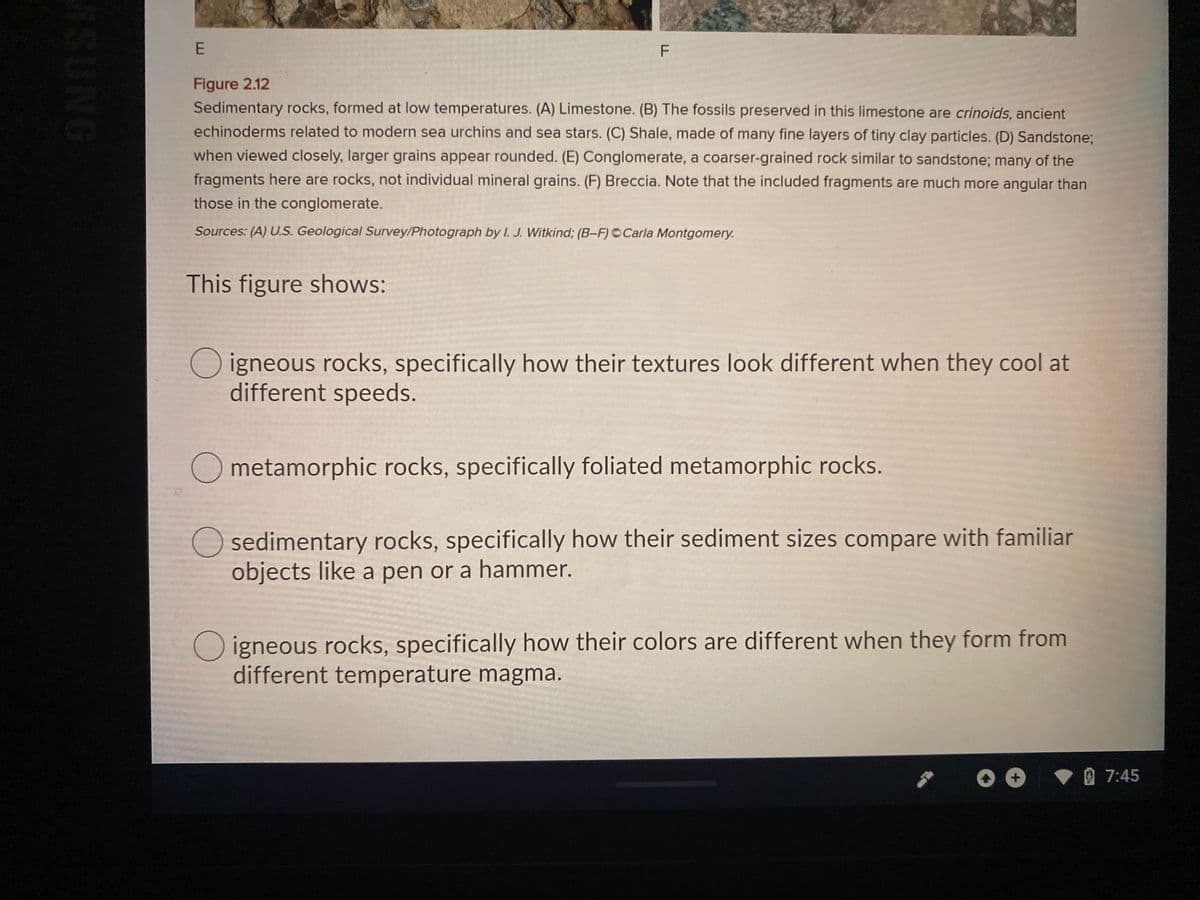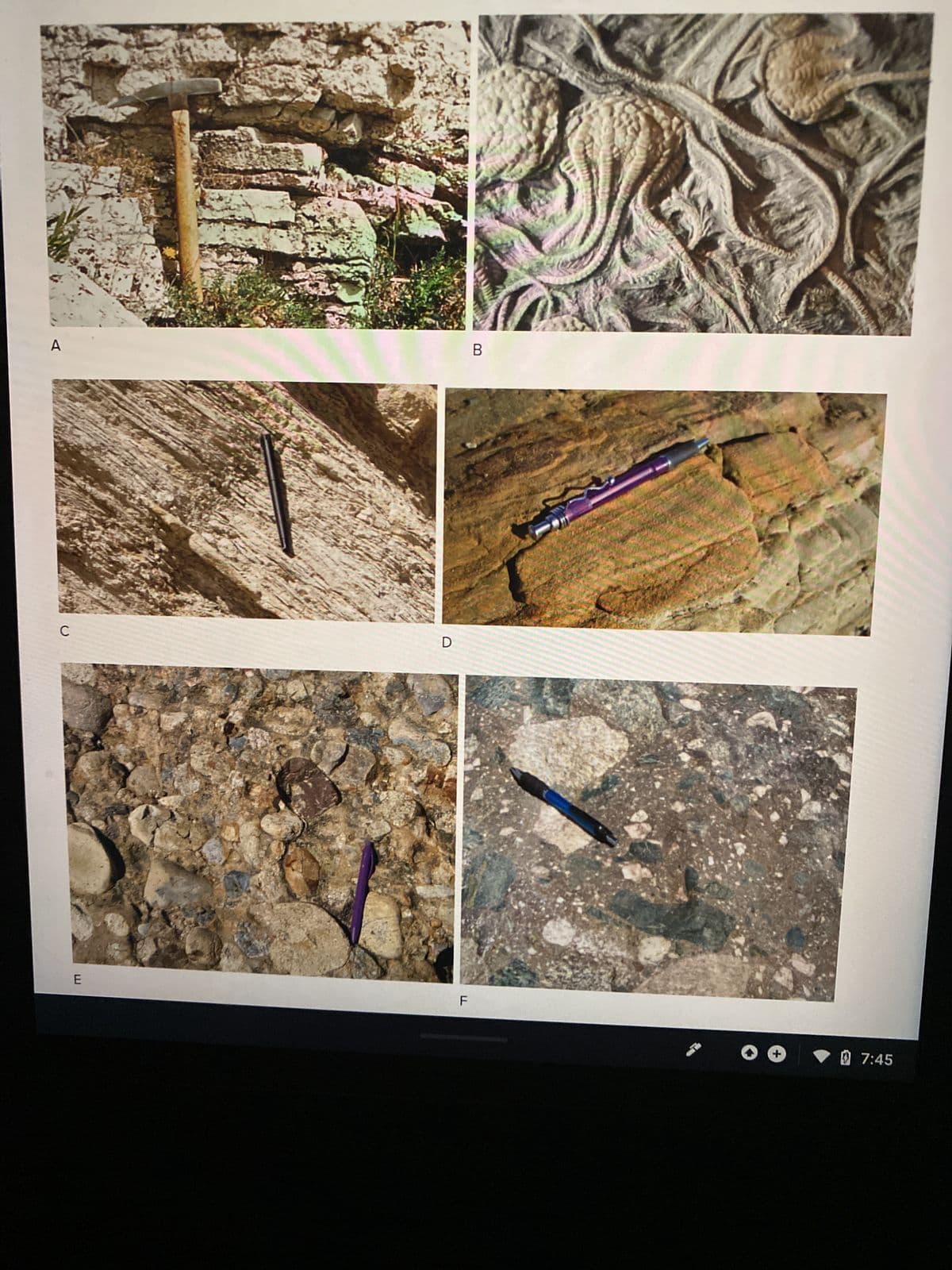This figure shows:
Applications and Investigations in Earth Science (9th Edition)
9th Edition
ISBN:9780134746241
Author:Edward J. Tarbuck, Frederick K. Lutgens, Dennis G. Tasa
Publisher:Edward J. Tarbuck, Frederick K. Lutgens, Dennis G. Tasa
Chapter1: The Study Of Minerals
Section: Chapter Questions
Problem 1LR
Related questions
Question

Transcribed Image Text:Figure 2.12
Sedimentary rocks, formed at low temperatures. (A) Limestone. (B) The fossils preserved in this limestone are crinoids, ancient
echinoderms related to modern sea urchins and sea stars. (C) Shale, made of many fine layers of tiny clay particles. (D) Sandstone;
when viewed closely, larger grains appear rounded. (E) Conglomerate, a coarser-grained rock similar to sandstone; many of the
fragments here are rocks, not individual mineral grains. (F) Breccia. Note that the included fragments are much more angular than
those in the conglomerate.
Sources: (A) U.S. Geological Survey/Photograph by I. J. Witkind; (B-F)OCarla Montgomery.
This figure shows:
igneous rocks, specifically how their textures look different when they cool at
different speeds.
O metamorphic rocks, specifically foliated metamorphic rocks.
O sedimentary rocks, specifically how their sediment sizes compare with familiar
objects like a pen or a hammer.
igneous rocks, specifically how their colors are different when they form from
different temperature magma.
7:45

Transcribed Image Text:LE
7:45
C.
A.
B.
Expert Solution
This question has been solved!
Explore an expertly crafted, step-by-step solution for a thorough understanding of key concepts.
Step by step
Solved in 3 steps with 1 images

Recommended textbooks for you

Applications and Investigations in Earth Science …
Earth Science
ISBN:
9780134746241
Author:
Edward J. Tarbuck, Frederick K. Lutgens, Dennis G. Tasa
Publisher:
PEARSON

Exercises for Weather & Climate (9th Edition)
Earth Science
ISBN:
9780134041360
Author:
Greg Carbone
Publisher:
PEARSON

Environmental Science
Earth Science
ISBN:
9781260153125
Author:
William P Cunningham Prof., Mary Ann Cunningham Professor
Publisher:
McGraw-Hill Education

Applications and Investigations in Earth Science …
Earth Science
ISBN:
9780134746241
Author:
Edward J. Tarbuck, Frederick K. Lutgens, Dennis G. Tasa
Publisher:
PEARSON

Exercises for Weather & Climate (9th Edition)
Earth Science
ISBN:
9780134041360
Author:
Greg Carbone
Publisher:
PEARSON

Environmental Science
Earth Science
ISBN:
9781260153125
Author:
William P Cunningham Prof., Mary Ann Cunningham Professor
Publisher:
McGraw-Hill Education

Earth Science (15th Edition)
Earth Science
ISBN:
9780134543536
Author:
Edward J. Tarbuck, Frederick K. Lutgens, Dennis G. Tasa
Publisher:
PEARSON

Environmental Science (MindTap Course List)
Earth Science
ISBN:
9781337569613
Author:
G. Tyler Miller, Scott Spoolman
Publisher:
Cengage Learning

Physical Geology
Earth Science
ISBN:
9781259916823
Author:
Plummer, Charles C., CARLSON, Diane H., Hammersley, Lisa
Publisher:
Mcgraw-hill Education,